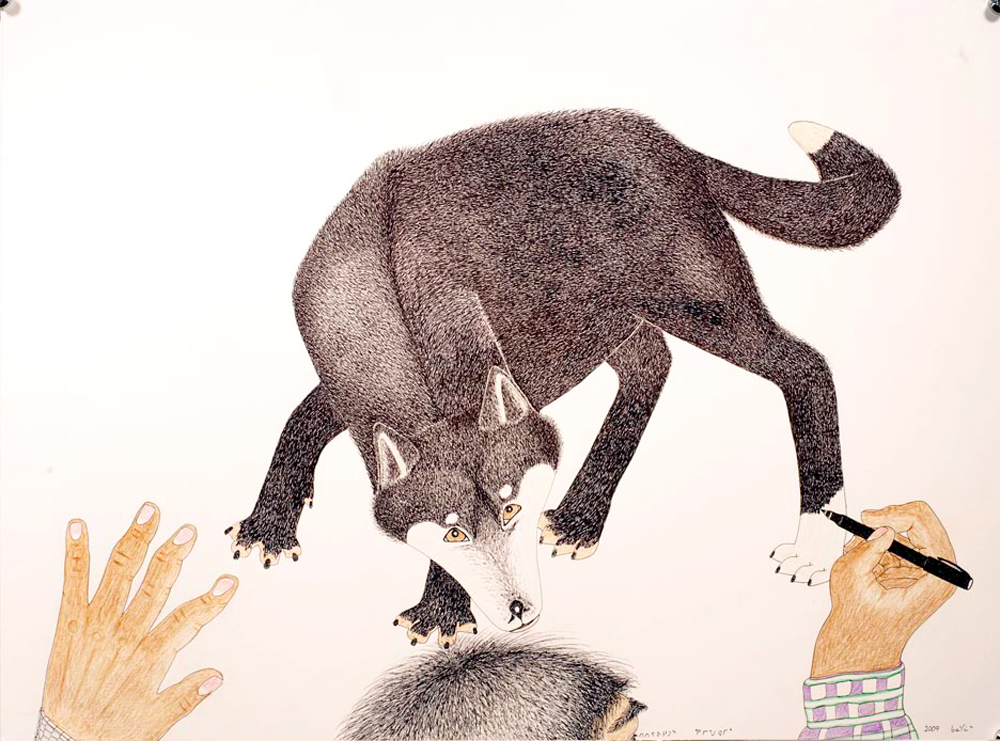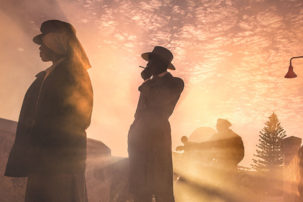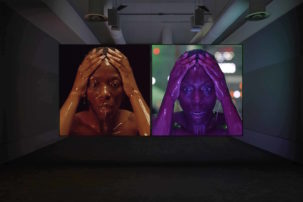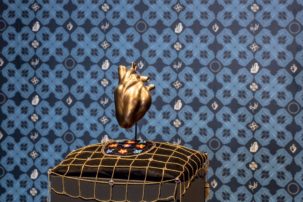In a groundbreaking moment for Inuit art worldwide, this year marks the first time that the work of an Inuit artist is being included in the Venice Biennale’s headlining exhibition.
The name of that exhibition this year is “Viva Arte Viva,” curated by Centre Pompidou’s Christine Macel, and the Inuit artist being honoured is Kananginak Pootoogook (1935–2010), a community leader and creator in Cape Dorset from the 1950s through to the end of his lifetime.
Ten ink-and-coloured-pencil drawings by Pootoogook have been installed in what Macel is calling the “Pavilion of the Earth” at the Venice Biennale’s Arsenale. (Scroll through this post, or click through the slideshow above, to see eight of the Pootoogook drawings now on preview in Venice, and opening to the public on May 13.)
Pootoogook’s drawings have been installed at the biennale alongside works by Slovenian artistic collective OHO, Japanese artistic collective THE PLAY, and UNESCO Artist for Peace Marko Pogancnik. Macel’s aim with this curatorial move? It would seem to be to expand ideas of what art can accomplish.
“For me, art has always been an activity of humankind that opens one’s self,” Macel recently told the Art Newspaper. “It is a practice for the person that creates and receives—that is, an act of opening oneself towards a proposal. And this proposal is something that [denies] your brain [the ability] to become narrow, because it confronts you with so many points of view, so many cultures. And the Biennale is an international event, so we’ll see the point of view of an Inuit artist or a Chinese one, and this makes you see your own position as relative, and makes you think that maybe your certitudes can be put into question. In itself, it is something that prompts new questioning and thoughts.”
Though Kananginak Pootoogook was widely exhibited during his lifetime—including at the Albers Gallery in San Francisco, the Galleria d’Arte Moderna e Contemporanea in Verona, and the Enbankment Gallery in London—“Viva Arte Viva” promises to shed renewed attention on Pootoogook’s closely observed views of contemporary Inuit life. (Indeed, in February, months before the Biennale was due to open, Pootoogook made Berlin art and fashion mag Sleek’s list of “10 Artists Everyone Will be Talking About” in Venice.)
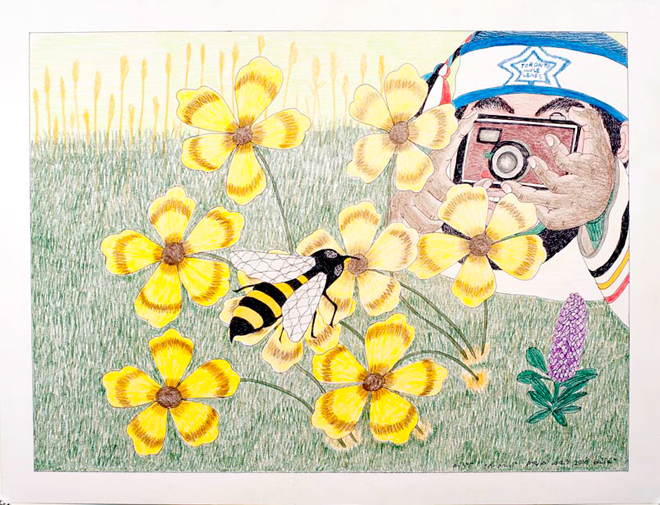 Kananginak Pootoogook, Untitled, 2010. Ink and coloured pencil on paper, 50.8 cm x 66 cm. Collection of Christopher Bredt and Jamie Cameron of Etobicoke, Ontario.
Kananginak Pootoogook, Untitled, 2010. Ink and coloured pencil on paper, 50.8 cm x 66 cm. Collection of Christopher Bredt and Jamie Cameron of Etobicoke, Ontario.
A “Big Thing” for Cape Dorset Art and Community
The inclusion of Pootoogook’s drawings in what is arguably the world’s most prestigious and influential art event is also meaningful to the community where he spent most of his life—Cape Dorset, Nunavut.
“It’s a very big thing for us,” says Joemie Takpaungi, buyer for the West Baffin Eskimo Co-operative in Cape Dorset. The co-operative has been a key node for creation and distribution of works of Inuit art in the 20th and 21st centuries, and Pootoogook “was a very dedicated person, co-op wise. He was one of the first to start the co-op.”
Takpaungi notes that Pootoogook was a designer and sculptor as well as someone who created drawings. All of these artistic forms allowed Pootoogook to engage in “telling stories from the past to the present day,” says Takpaungi.
Certainly a theme of Inuit life past and present is reflected in the Pootoogook drawings included in the Venice Biennale. Most of these drawings were made in the last few years prior to Pootoogook’s death in 2010, when the contrast to his early life (he was born in 1935) would have been the strongest.
One drawing made in 2009, for instance, shows the results of a successful walrus hunt, while another, made the following year, shows an Inuit person in a Toronto Maple Leafs toque taking a photograph of a bee suckling nectar from a flower. Two drawings put motorized technology widely used by Inuit—ski-doos and ATVs—front and centre.
Poignantly, perhaps, one the drawings Pootoogook made in the year of his death, picturing an Inuit person behind some large floral blooms, is titled In 1935 the future was uncertain but today it’s much different. And the self-reflexive drawing Untitled (Self-Portrait of Kananginak drawing a Wolf) from 2009 suggests the self-awareness that Pootoogook brought to his practice, and to ideas of what Inuit art is or “should” be.
A number of Pootoogook family members and Cape Dorset residents are hoping to catch the Venice exhibition, and related events, via Skype in coming days.
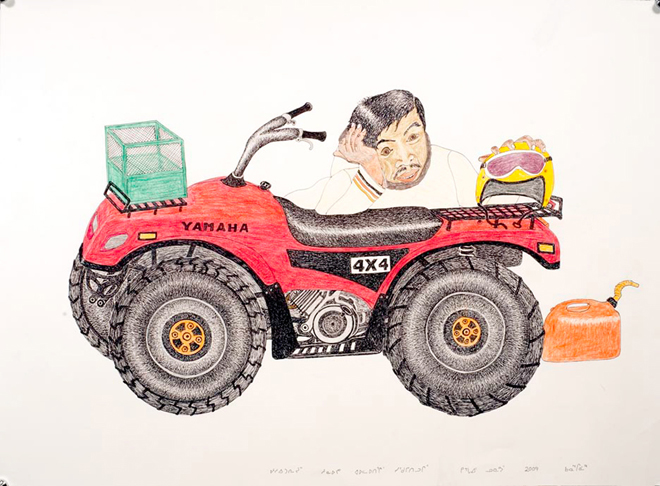 Kananginak Pootoogook, He thinks he has run out of gas, but the engine is shot, 2009. Ink and coloured pencil on paper, 55.88 cm x 76.2 cm. Collection of Marnie Schreiber, Burlington, Ontario.
Kananginak Pootoogook, He thinks he has run out of gas, but the engine is shot, 2009. Ink and coloured pencil on paper, 55.88 cm x 76.2 cm. Collection of Marnie Schreiber, Burlington, Ontario.
Venice Biennale Showing a “Total Surprise” at First
Interestingly, this important international showing caught a key representative of Pootoogook’s estate—Toronto’s Dorset Fine Arts—as a “total surprise” at first, says William Huffman, marketing manager at Dorset Fine Arts.
“We got an inquiry from the Centre Pompidou about Kananginak, probably a year and a half ago, so we knew that something was happening internationally, and we thought it would be at the Centre Pompidou,” Huffman says. “But then we started hearing from collectors getting requests for work,” and the situation started to become clearer—that the Centre Pompidou was laying the groundwork for Christine Macel’s Venice Biennale exhibition.
“We are still unclear how she [Macel] engaged with Kananginak,” Huffman says, though he notes there are some dealers of Pootoogook’s work in Paris that could have provided a geographic link.
Geographically, it is also interesting to reflect on the locations of collections that are lending Pootoogook works to the Venice Biennale exhibition. Two are from the personal collection of Marnie Schreiber of Burlington, Ontario, for instance, while one is from the collection of the Brooklyn Museum in New York. One is from the collection of the Carleton University Art Gallery in Ottawa, while three more are from the collection of John and Joyce Price of Mercer Island, Washington. Two drawings from the collection of Samuel and Esther Sarick in Toronto are also on view.
However Macel got wind of Pootoogook’s art, and wherever the drawings are stored after the biennale, says Huffman, it’s clear that a “renaissance of Inuit artwork” is at hand.
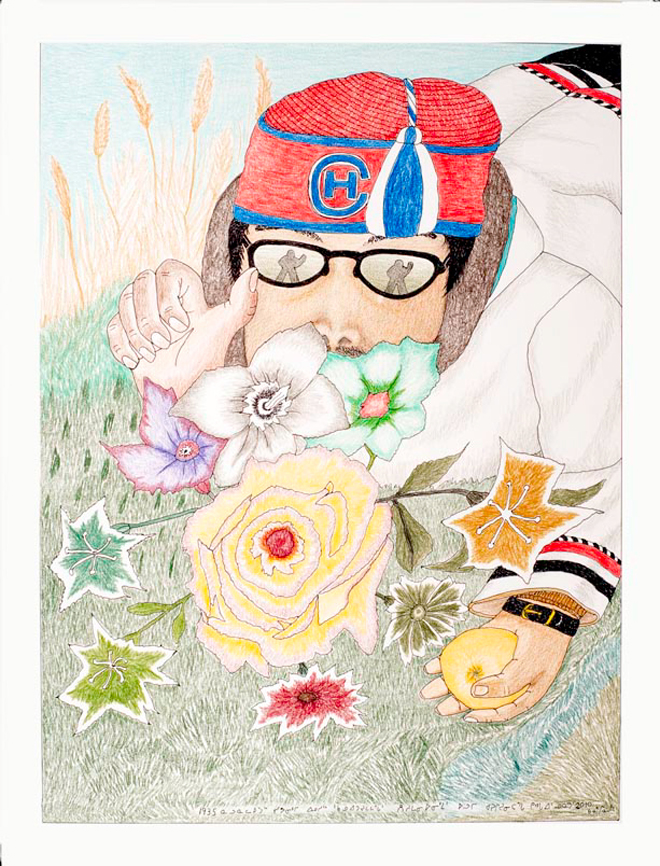 Kananginak Pootoogook, In 1935 the future was uncertain but today it’s much different, 2010. Ink and coloured pencil on paper, 66 cm x 50.8 cm. Collection of Marnie Schreiber, Burlington, Ontario.
Kananginak Pootoogook, In 1935 the future was uncertain but today it’s much different, 2010. Ink and coloured pencil on paper, 66 cm x 50.8 cm. Collection of Marnie Schreiber, Burlington, Ontario.
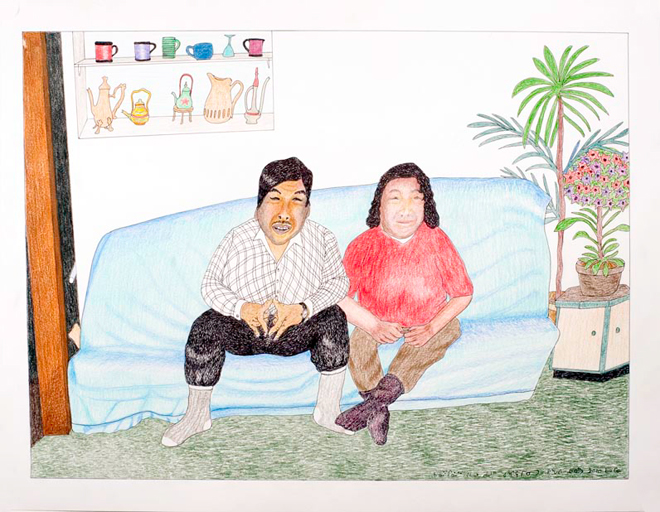 Kananginak Pootoogook, Untitled (Kananginak and his wife Shooyoo in their home), 2010. Ink and coloured pencil on paper, 50.8 cm x 66 cm. Collection of John and Joyce Price, Mercer Island, Washington.
Kananginak Pootoogook, Untitled (Kananginak and his wife Shooyoo in their home), 2010. Ink and coloured pencil on paper, 50.8 cm x 66 cm. Collection of John and Joyce Price, Mercer Island, Washington.
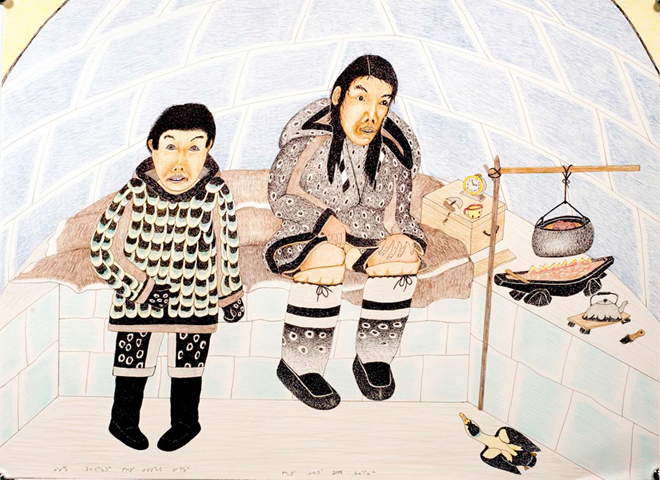 Kananginak Pootoogook, Untitled, 2009. Ink and coloured pencil on paper, 56 cm x 76 cm. Collection of Samuel and Esther Sarick, Toronto.
Kananginak Pootoogook, Untitled, 2009. Ink and coloured pencil on paper, 56 cm x 76 cm. Collection of Samuel and Esther Sarick, Toronto.
 Kananginak Pootoogook, Untitled (Whale Hunt), 2009. Ink and coloured pencil on paper, 122 cm x 244 cm. Collection of John and Joyce Price, Mercer Island, Washington.
Kananginak Pootoogook, Untitled (Whale Hunt), 2009. Ink and coloured pencil on paper, 122 cm x 244 cm. Collection of John and Joyce Price, Mercer Island, Washington.
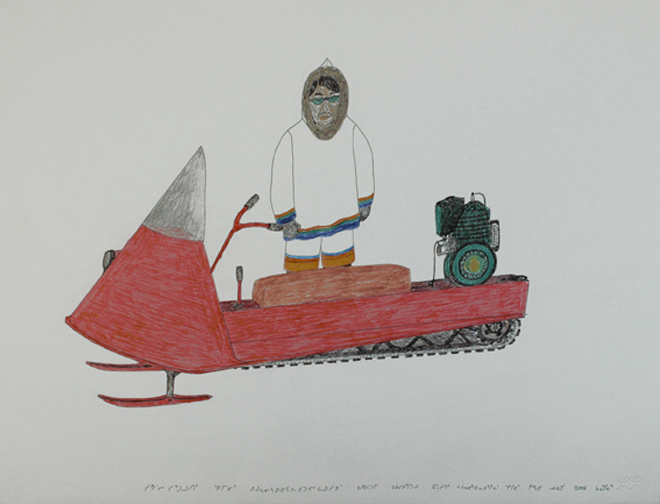 Kananginak Pootoogook, Untitled, 2006. Ink and coloured pencil on paper, 50.8 cm x 66 cm. Collection of the Carleton University Art Gallery, Ottawa.
Kananginak Pootoogook, Untitled, 2006. Ink and coloured pencil on paper, 50.8 cm x 66 cm. Collection of the Carleton University Art Gallery, Ottawa.
This article was corrected on May 11, 2017. The original incorrectly labelled Untitled (2010) as being from the collection of Marnie Schreiber. It is from the collection of Christopher Bredt and Jamie Cameron. We regret the error.

